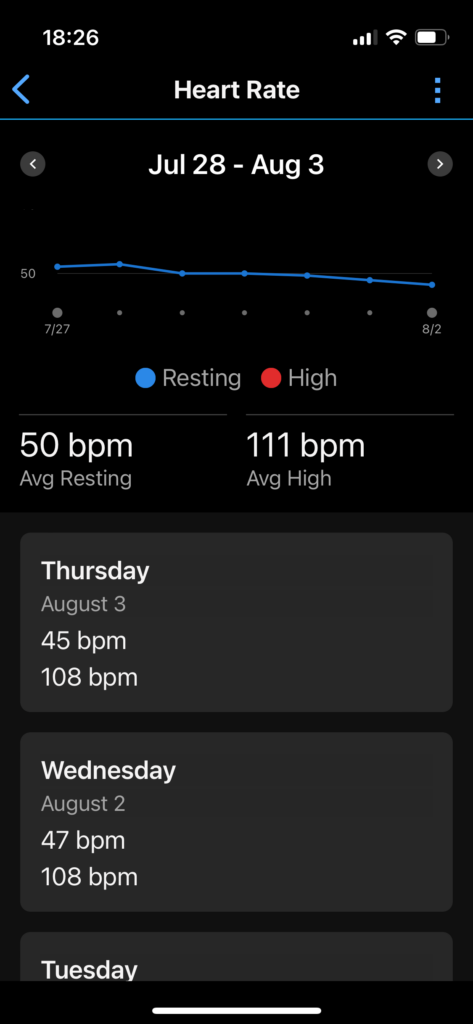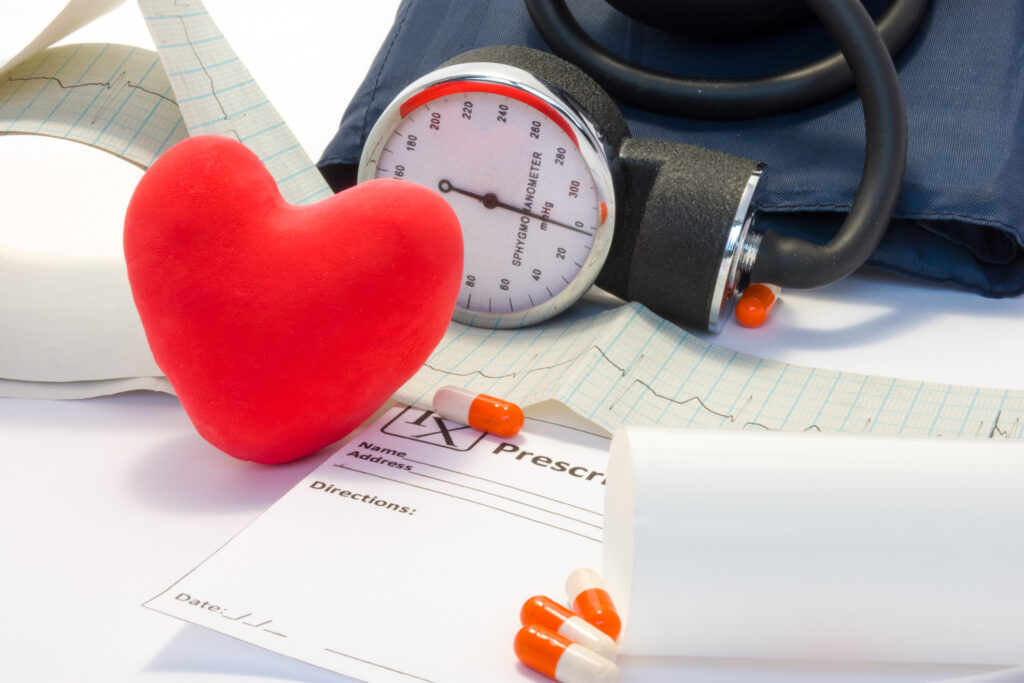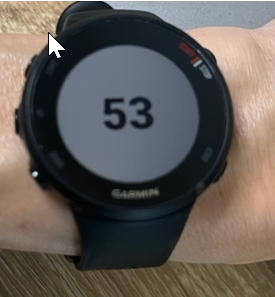
Are you looking for a reliable way to track your fitness or need some additional motivation for reaching a fitness goal? Your resting heart rate is valuable wellness metric and tracking it can help you do both. I’ve been tracking mine for several years now and have leveraged it to help me reach my fitness goals.
In general, resting heart rate is a valuable metric for assessing fitness and tracking progress over time. It can also be motivational for sticking to an exercise program and adopting healthy lifestyle habits. There are many factors that affect resting heart rate and learning how your body responds to these can help you make better choices and decisions.
Your resting heart rate is a personalized metric that provides valuable insights into your current health, exercise program, and overall health. Learning why it is so important and how you can improve your resting heart rate can transform you into a fitness enthusiast and help you reach amazing fitness levels. Read on to find out how you can leverage this powerful metric.
Resting Heart Rate: What is it and why it is important
Resting heart rate (RHR)is the number of heart beats per minute when the body is at rest. This is usually measured in the morning before you get out of bed or when you have been sitting or lying down for a while.
It is an important metric of health and well-being for numerous reasons including:
1. Cardiovascular Health: Hear rate provides valuable insights into the health of your cardiovascular system. A higher-than-normal RHR may indicate potential issues with your heart or circulation.
2. Fitness Level: Heart rate is a useful indicator of your overall fitness level. Athletes and individuals with better cardiovascular fitness tend to have lower RHRs because their hearts are more efficient at pumping blood.
3. Stress and Recovery: Resting heart rate can reflect your body’s stress levels and recovery. An elevated RHR can be a sign of stress or insufficient recovery from physical activity or other stressors. It can also be the first sign of a cold coming on.
4. Longevity: Numerous studies have shown a correlation between a lower resting heart rate and increased longevity. A lower heart rate indicates that the heart is working more efficiently, reducing wear and tear on this vital organ over time.
5. Training Progress: For athletes and fitness enthusiasts, tracking changes in RHR can help assess the effectiveness of their training programs. As fitness improves, RHR tends to decrease.
6. Potential Health Issues: A consistently high RHR may be an early warning sign of various health conditions, including hypertension, heart disease, diabetes, or thyroid problems. Regular monitoring of RHR can aid in early detection.
The ideal resting heart rate
As a general rule, the lower the resting heart rate, the healthier you are. Resting heart rates are normally between 60-100 bpm. Athletes usually have lower resting heart rates which can be in the 40’s and 50’s. Some elite athletes may have even lower resting heart rates.
There are some health conditions that may result in a lower resting heart rate that are not necessarily a reflection of good fitness and good health. Some heart conditions, medications, electrolyte deficiencies, eating disorders and more can cause a slower resting heart rate.
If your resting heart rate is slower than normal it is always best to check with a medical professional. If you experience dizziness, chest pains, confusion, fatigue, or shortness of breath be sure to seek immediate medical attention.
Factors affecting resting heart rate

Fitness level – As you get fitter your heart muscles get more efficient at delivering blood to your muscles. As the heart gets stronger, it can deliver more blood with each beat resulting in less beats per minute when the body is at rest.
Stress – Stress directly affects the heart rate for most individuals. When under stress, the body releases hormones that elevate the heart rate, blood pressure, and respiratory rate.
Hydration – When the body is dehydrated, the heart must work harder to stabilize blood flow. Conversely, studies have shown that drinking water lowered heart rates for up to 60 minutes after the drink.
Caffeine Intake – Caffeine is a stimulant and increases the heart rate. Caffeine affects people differently so how much caffeine can elevate a person’s heart rate will be very individual.
Medications – Medications can speed up or slow down heart rates. Some medications such as beta blockers may be taken for this intended purpose, while others may be a side effect. For example, some antibiotics are known for speeding up the heart.
Tips for lowering resting heart rate
Regularly exercise – Consistently exercising can lower your resting heart rate, but it will depend on your current fitness level. If you already engage in regular aerobic activity, you may not see much improvement by shifting your focus to weights. However, an interesting study in 2009 found that 1 hour of intense physical activity a week lowered resting heart rate more than an hour of low intensity effort (see study here).
Reduce stress – Making lifestyle changes to reduce and manage stress can result in a lower resting heart rate. Some strategies include deep breathing, exercise, listening to soothing music, spending time in nature, and other relaxation techniques. Finding and consistently engaging in strategies that work for you may take some time before you see results.
Improving sleep habits – The quality and quantity of your sleep can greatly affect your resting heart rate. Target to get 7-9 hours of restful sleep per night. In addition, sticking to a consistent sleep schedule that includes limiting eating and screen time before bed promotes better sleep.
Limit Stimulants – Reducing or eliminating stimulants like caffeine or nicotine can lower your resting heart rate. Limit consuming caffeine and sugar later in the day as this can also affect your sleep and result in an elevated heart rate in the morning.
Healthy Diet – Adjusting to a diet rich in fruits, vegetables, whole grains, and healthy fats can lower resting heart rates. Limit sugar intake, excessive caffeine, and processed foods which increase stress levels and can elevate resting heart rate.
Tracking resting heart rate

Tracking your resting heart rate allows you to see how your body responds over time to different strategies. This can help you make informed decisions about your health and provide additional motivation for adopting healthy lifestyle choices.
To see meaningful changes in your resting heart rate due to fitness improvements, you should track it over time. There are many things that affect your heart rate in the short term. In addition, daily fluctuations can make it challenging to assess progress.
Personal Experience
I have been tracking my resting heart rate for several years now. I have noticed that both major and minor lifestyle habits affect my resting heart rate.
Some of the biggest impacts to my long-term resting heart rate have been stress and exercise. I have been able to bring my average resting heart rate down 10-15 beats by focusing on these two strategies.
On a daily basis, I’ve noticed that sleep, diet, overtraining, and illness can temporarily impact my resting heart rate. Being aware of how these factors impact my resting heart rate has motivated me to make better decisions over time.
I continue to monitor my resting heart as it has assisted me to reach many fitness goals. I have also found it to be a good motivator to be consistent in making healthy lifestyle choices.
Below are some of the specific factors I noticed over time that have affected my resting heart rate.
Stress: When changing jobs, I saw my resting heart rate decrease by 5 bpm with no other lifestyle changes. Tracking my resting heart rate gave me greater insight into the the effect stress plays in my life.
Exercise: I lowered my resting heart rate by nearly 10 bpm in a few months during an ultra-marathon training cycle (it was my first ultra-marathon). As my exercise levels decreased in the weeks after the event, my resting heart rate increased by 5-10 beats.
Rest and Recovery: I do notice that my resting heart rate increases after a particularly long and hard work out. I also experienced a higher resting heart rate after a poor’s night sleep. I try to treat an elevated heart rate as a warning signal and incorporate more rest or do a lighter workout. See my article here for more on heart rate and recovery.
There are limits for using RHR for assessing fitness

Tracking your resting heart rate is a valuable metric of fitness and overall health, but it does have limits. Below are some factors to keep in mind when assessing your fitness progress.
Individual Variation: RHR varies widely among individuals. What is considered a “normal” RHR can range from 60 to 100 beats per minute. Factors like genetics, age, gender, and overall health can influence an individual’s baseline RHR, making it important to consider personalized norms.
Day-to-Day Variability: RHR can fluctuate from day to day due to various factors, including stress, illness, lack of sleep, or changes in hydration and nutrition. These fluctuations can make it challenging to track changes accurately over short periods.
Fitness-Specific: While RHR is a good indicator of cardiovascular fitness, it doesn’t provide a complete picture of overall fitness. Fitness encompasses strength, flexibility, and other components that RHR doesn’t measure.
Medications and Health Conditions: Certain medications and health conditions can influence RHR. For example, medications that affect heart rate or conditions like thyroid disorders can alter RHR independently of fitness levels.
Age-Related Changes: RHR tends to increase with age, even in individuals with excellent fitness levels. This age-related increase can sometimes mask improvements in cardiovascular fitness.
Not a Sole Indicator of Overall Health: RHR should be considered alongside other metrics such as blood pressure, cholesterol levels, and body composition to assess overall health comprehensively.
Overtraining: While a decreasing RHR can indicate improved fitness, an extremely low RHR can also be a sign of overtraining, which can have negative health consequences. Balance and context are essential.
Accuracy of Measurement: The accuracy of RHR measurements can vary based on the method used. For example, measurements taken manually might be less accurate than those obtained from heart rate monitors or fitness trackers. Using a consistent method to track resting heart rate is best.
Resources for monitoring resting heart rate

Wearable wrist devices are the easiest way to track resting heart rate. Taking your pulse first thing in the morning before getting out of bed is another good way to monitor your resting heart rate.
Many smart watches and fitness trackers with heart rate monitors will automatically track your resting heart rate. It is best to sleep with the devices for the most accurate and consistent readings.
I have used many devices with heart rate monitors over the years. See my article here for a comparison of some of the different heart rate monitors for beginners on a budget.
Key Takeaways
Tracking your resting heart rate can be a powerful tool for tracking fitness to reach your fitness goals. It also provides additional motivation for making good choices to support a healthy lifestyle.
While it is not the sole indicator of good health and well-being, it can be leveraged to help you get in better shape. With all the many wearable devices to choose from, it has never been easier to monitor your fitness and transform yourself into a fitness enthusiast!